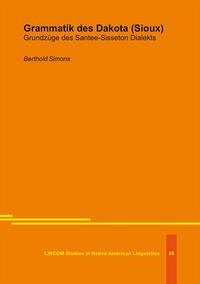Das Dakota ist eine zur Sioux-Familie gehörende lebende indigene Sprache Nordamerikas. Der Schwerpunkt der vorliegenden Grammatik liegt auf dem Santee-Sisseton-Dialekt; in den Beispielen liegt er auf ganzen Sätzen und Textausschnitten. Behandelt werden Phonetik und Phonologie, die Wortarten und die Wortbildungsmittel, die grammatischen Kategorien, der einfache und komplexe Satzbau sowie Besonderheiten der Literatur des Dakota unter funktionalen Aspekten. Das Dakota gilt als Repräsentant des aktivischen Sprachbaus und weist in seiner Grammatik dessen typische Merkmale auf: Die strikte Unterscheidung zwischen aktiven und stativen Verben und eine Dominanz der Verbalstämme. Die Kodierung der syntaktischen Funktionen von Subjekt und Objekt basiert auf der festen Wortstellung Subjekt-Objekt-Verb (SOV). Die Kennzeichnung der semantischen Rollen Agens, Patiens, Rezipient usw. beruht auf der Kontrolle über die Verbalhandlung und wird mit den aktiven vs. stativen Pronominalreihen markiert. Ein Inventar von Lokativ- und Instrumentalpräfixen nuanciert die Verbbedeutung. Klitika am Satzende bestimmen den pragmatischen Status eines Satzes als Frage, Vermutung, Erzählung usw. und kennzeichnen optional die Sprechereinstellung. Mit einem alten, nicht mehr produktiven Bestand an Nominalklassifikatoren sind große Teile des Wortschatzes inhaltlich gegliedert. Temporale, lokale und modale Relationen werden mit einem umfangreichen Inventar von Adverbien, Verben und anderen sprachlichen Mitteln ausgedrückt. Mit vier ergänzenden Einstiegslektionen können Dakota-Lernende ein Basisinventar zur praktischen Verständigung erwerben.Dakota is a living indigenous language of North America belonging to the Sioux family. This grammar focuses on the description of the Santee-Sisseton dialect, and in the examples on entire sentences and text excerpts. Phonetics and phonology, the parts of speech, word formation, the grammatical categories, the simple and complex sentence structure as well as special features of the Dakota literature are discussed from a functional point of view. Dakota is considered to be a representative of the active language type and has the typical features in its grammar: a strict distinction between active and stative verbs and a dominance of the verbal stems. The coding of the syntactic functions of subject and object is based on the rigid word order subject-object-verb (SOV). The coding of the semantic roles agent, patient, recipient, etc. is based on control over the verbal action and is marked with the active vs. stative pronominal series. An inventory of locative and instrumental prefixes nuances the verb meaning, sentence-final clitics determine the pragmatic status of a sentence as a question, conjecture, narrative, etc. and optionally characterize the speaker's attitude. Parts of the lexicon are structured according to an older, no longer productive stock of nominal classifiers. Temporal, local and modal relations are expressed using an extensive inventory of adverbs, verbs and other linguistic means. With four additional introductory lessons, Dakota learners can acquire a basic inventory for easy communication.
Bitte wählen Sie Ihr Anliegen aus.
Rechnungen
Retourenschein anfordern
Bestellstatus
Storno

